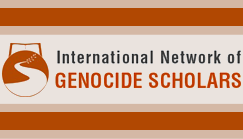Event Title
Tuluwat: Remembrance, Reconciliation, and Restitution at the Center of World
Submission Type
Video
Abstract
Traveling throughout the United States it is difficult not to pass a site of a mass atrocity or genocidal act, which often goes without notice or recognition. The history of the United States is one that is born from genocide, which is often unacknowledged and when it contentious. Wounds of the past are left open to fester contributing to the inequalities and misunderstandings of today. The promotion of social justice in the present for actions of the past can meet with obstacles that impede the healing of historical trauma in communities. Indigenous communities in Northern California have been memorializing the atrocities of the past with candlelight vigils bringing recognition to these acts and helping communities to start the difficult dialogues necessary for healing. This paper will examine the sources, reasons, and impacts of remembrance through an annual candlelight vigil that brought recognition to the Indian Island Massacre of 1860. Further, it will explore how this memorial served as a conduit for significant acts of reconciliation. In 2004 the City of Eureka, in California returned forty-acres of land on Indian Island in Humboldt Bay, the center of the Wiyot world and the site of a massacre that brought them to the brink of extinction, to the Wiyot Tribe. Ten years later the City of Eureka initiated the extraordinary action of apologizing to the Wiyot Tribe for the massacre that occurred one hundred fifty-four years prior, in which its citizens took to boats in the dark of night and ended the lives of Wiyot women, children, and elderly. In October 2019, the City of Eureka returned its remaining land holdings to the Wiyot tribe furthering the process of reconciliation and restitution.

Tuluwat: Remembrance, Reconciliation, and Restitution at the Center of World
Traveling throughout the United States it is difficult not to pass a site of a mass atrocity or genocidal act, which often goes without notice or recognition. The history of the United States is one that is born from genocide, which is often unacknowledged and when it contentious. Wounds of the past are left open to fester contributing to the inequalities and misunderstandings of today. The promotion of social justice in the present for actions of the past can meet with obstacles that impede the healing of historical trauma in communities. Indigenous communities in Northern California have been memorializing the atrocities of the past with candlelight vigils bringing recognition to these acts and helping communities to start the difficult dialogues necessary for healing. This paper will examine the sources, reasons, and impacts of remembrance through an annual candlelight vigil that brought recognition to the Indian Island Massacre of 1860. Further, it will explore how this memorial served as a conduit for significant acts of reconciliation. In 2004 the City of Eureka, in California returned forty-acres of land on Indian Island in Humboldt Bay, the center of the Wiyot world and the site of a massacre that brought them to the brink of extinction, to the Wiyot Tribe. Ten years later the City of Eureka initiated the extraordinary action of apologizing to the Wiyot Tribe for the massacre that occurred one hundred fifty-four years prior, in which its citizens took to boats in the dark of night and ended the lives of Wiyot women, children, and elderly. In October 2019, the City of Eureka returned its remaining land holdings to the Wiyot tribe furthering the process of reconciliation and restitution.





Comments
View the agenda item.
View Kerri J. Malloy's bio.